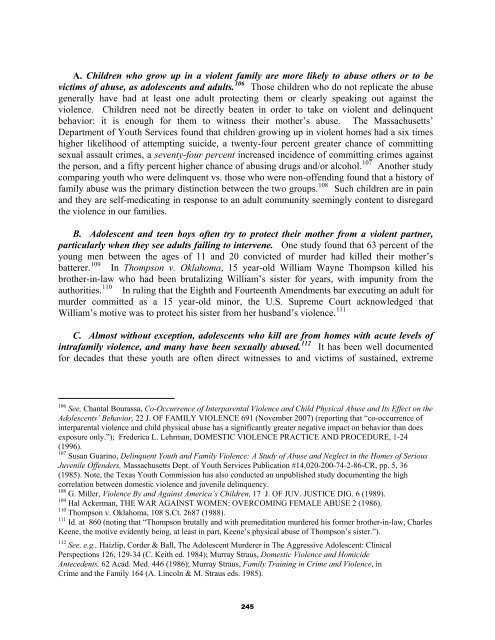A Judge’s Guide
A Judge’s Guide
A Judge’s Guide
You also want an ePaper? Increase the reach of your titles
YUMPU automatically turns print PDFs into web optimized ePapers that Google loves.
A. Children who grow up in a violent family are more likely to abuse others or to be<br />
victims of abuse, as adolescents and adults. 106 Those children who do not replicate the abuse<br />
generally have had at least one adult protecting them or clearly speaking out against the<br />
violence. Children need not be directly beaten in order to take on violent and delinquent<br />
behavior: it is enough for them to witness their mother’s abuse. The Massachusetts’<br />
Department of Youth Services found that children growing up in violent homes had a six times<br />
higher likelihood of attempting suicide, a twenty-four percent greater chance of committing<br />
sexual assault crimes, a seventy-four percent increased incidence of committing crimes against<br />
the person, and a fifty percent higher chance of abusing drugs and/or alcohol. 107 Another study<br />
comparing youth who were delinquent vs. those who were non-offending found that a history of<br />
family abuse was the primary distinction between the two groups. 108 Such children are in pain<br />
and they are self-medicating in response to an adult community seemingly content to disregard<br />
the violence in our families.<br />
B. Adolescent and teen boys often try to protect their mother from a violent partner,<br />
particularly when they see adults failing to intervene. One study found that 63 percent of the<br />
young men between the ages of 11 and 20 convicted of murder had killed their mother’s<br />
batterer. 109 In Thompson v. Oklahoma, 15 year-old William Wayne Thompson killed his<br />
brother-in-law who had been brutalizing William’s sister for years, with impunity from the<br />
authorities. 110 In ruling that the Eighth and Fourteenth Amendments bar executing an adult for<br />
murder committed as a 15 year-old minor, the U.S. Supreme Court acknowledged that<br />
William’s motive was to protect his sister from her husband’s violence. 111<br />
C. Almost without exception, adolescents who kill are from homes with acute levels of<br />
intrafamily violence, and many have been sexually abused. 112 It has been well documented<br />
for decades that these youth are often direct witnesses to and victims of sustained, extreme<br />
106<br />
See, Chantal Bourassa, Co-Occurrence of Interparental Violence and Child Physical Abuse and Its Effect on the<br />
Adolescents’ Behavior, 22 J. OF FAMILY VIOLENCE 691 (November 2007) (reporting that “co-occurrence of<br />
interparental violence and child physical abuse has a significantly greater negative impact on behavior than does<br />
exposure only.”); Frederica L. Lehrman, DOMESTIC VIOLENCE PRACTICE AND PROCEDURE, 1-24<br />
(1996).<br />
107<br />
Susan Guarino, Delinquent Youth and Family Violence: A Study of Abuse and Neglect in the Homes of Serious<br />
Juvenile Offenders, Massachusetts Dept. of Youth Services Publication #14,020-200-74-2-86-CR, pp. 5, 36<br />
(1985). Note, the Texas Youth Commission has also conducted an unpublished study documenting the high<br />
correlation between domestic violence and juvenile delinquency.<br />
108<br />
G. Miller, Violence By and Against America’s Children, 17 J. OF JUV. JUSTICE DIG. 6 (1989).<br />
109<br />
Hal Ackerman, THE WAR AGAINST WOMEN: OVERCOMING FEMALE ABUSE 2 (1986).<br />
110<br />
Thompson v. Oklahoma, 108 S.Ct. 2687 (1988).<br />
111<br />
Id. at 860 (noting that “Thompson brutally and with premeditation murdered his former brother-in-law, Charles<br />
Keene, the motive evidently being, at least in part, Keene’s physical abuse of Thompson’s sister.”).<br />
112 See, e.g., Haizlip, Corder & Ball, The Adolescent Murderer in The Aggressive Adolescent: Clinical<br />
Perspections 126, 129-34 (C. Keith ed. 1984); Murray Straus, Domestic Violence and Homicide<br />
Antecedents, 62 Acad. Med. 446 (1986); Murray Straus, Family Training in Crime and Violence, in<br />
Crime and the Family 164 (A. Lincoln & M. Straus eds. 1985).<br />
245


